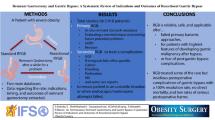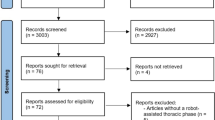Abstract
Introduction
Reports on outcomes after double-staple technique (DST) for total and proximal gastrectomy are limited, originating mostly from Asian centers. Our objective was to examine anastomotic leak and stricture with DST for esophagoenteric anastomosis in gastric cancer patients.
Methods
A single institution review was performed for patients who underwent total/proximal gastrectomy with DST between 2006 and 2015. DST was performed using transoral anvil delivery (OrVil™) with end-to-end anastomosis. Clinical characteristics and outcomes, including anastomotic leak and stricture, were recorded.
Results
Overall, DST was performed in 60 patients [total gastrectomy (81.7 %, n = 49/60), proximal gastrectomy (10.0 %, n = 6/60), and completion gastrectomy (8.3 %, n = 5/60)]. Neoadjuvant chemotherapy was administered to 21 patients (35.0 %), and 6 patients (10.0 %) received external beam radiation therapy prior to completion gastrectomy. Operative approach was open (51.7 %, n = 31/60), laparoscopic (43.3 %, n = 26/60), or robotic (5.0 %, n = 3/60). Anastomotic leak occurred in 6.7 % (n = 4/60), while stricture independent of leak was identified in 19.0 % (n = 11/58) of patients. Complications occurred in 38.3 % (n = 23/60) of patients, of which 52 % were classified as Clavien-Dindo grades III–V complications.
Conclusion
In the largest Western series of DST for esophagoenteric anastomoses in gastric cancer surgery, our experience demonstrates that DST is safe and effective with low rates of leak and stricture.




Similar content being viewed by others
References
Inaba K., S.S., Ishida Y., Taniguchi K., Isogaki J., Kanaya S., Overlap method: novel intracorporeal esophagojejunostomy after laparoscopic total gastrectomy. J Am Coll Surg, 2010. 211: p. e25-9.
Shim, J.H., et al., Various types of intracorporeal esophagojejunostomy after laparoscopic total gastrectomy for gastric cancer. Gastric Cancer, 2013. 16(3): p. 420–7.
Uyama, I., et al., Laparoscopic side-to-side esophagogastrostomy using a linear stapler after proximal gastrectomy. Gastric Cancer, 2001. 4(2): p. 98–102.
Kunisaki, C., et al., Application of the transorally inserted anvil (OrVil) after laparoscopy-assisted total gastrectomy. Surg Endosc, 2011. 25(4): p. 1300–5.
Liao, G.Q., et al., Laparoscopy-assisted total gastrectomy with trans-orally inserted anvil (OrVil): a single institution experience. World J Gastroenterol, 2013. 19(5): p. 755–60.
Xie, J.W., et al., A safe anastomotic technique of using the transorally inserted anvil (OrVil) in Roux-en-Y reconstruction after laparoscopy-assisted total gastrectomy for proximal malignant tumors of the stomach. World J Surg Oncol, 2013. 11: p. 256.
Zuiki, T., et al., Stenosis after use of the double-stapling technique for reconstruction after laparoscopy-assisted total gastrectomy. Surg Endosc, 2013. 27(10): p. 3683–9.
Hamner JB, K.J., Laparoscopic Distal/Subtotal Gastrectomy, in Surgery for Cancers of the Gastrointestinal Tract: a Step-by-Step Approach, G.-A.J. Kim J, Editor. 2014, Springer: New York.
Clavien, P.A., et al., The Clavien-Dindo classification of surgical complications: five-year experience. Ann Surg, 2009. 250(2): p. 187–96.
Jeong, O. and Y.K. Park, Intracorporeal circular stapling esophagojejunostomy using the transorally inserted anvil (OrVil) after laparoscopic total gastrectomy. Surg Endosc, 2009. 23(11): p. 2624–30.
Kachikwu, E.L., et al., Minimally invasive total gastrectomy for gastric cancer: a pilot series. J Gastrointest Surg, 2011. 15(1): p. 81–6.
LaFemina, J., et al., Esophagojejunal reconstruction after total gastrectomy for gastric cancer using a transorally inserted anvil delivery system. Ann Surg Oncol, 2013. 20(9): p. 2975–83.
Marangoni, G., et al., OrVil-assisted anastomosis in laparoscopic upper gastrointestinal surgery: friend of the laparoscopic surgeon. Surg Endosc, 2012. 26(3): p. 811–7.
Sakuramoto, S., et al., Technique of esophagojejunostomy using transoral placement of the pretilted anvil head after laparoscopic gastrectomy for gastric cancer. Surgery, 2010. 147(5): p. 742–7.
Funding Support
Dr. Chao’s efforts were supported by the National Cancer Institute of the National Institutes of Health under award number NIH 5K12CA001727-20. The content is solely the responsibility of the authors and does not necessarily represent the official views of the National Institutes of Health. There was no additional funding provided by any source.
Conflict of Interest
The authors declare that they have no competing interests.
Author information
Authors and Affiliations
Corresponding authors
Additional information
Byrne Lee and Joseph Kim are co-senior authors.
Rights and permissions
About this article
Cite this article
Choi, A.H., Arrington, A., Falor, A. et al. Assessment of the Double-Staple Technique for Esophagoenteric Anastomosis in Gastric Cancer. J Gastrointest Surg 20, 688–692 (2016). https://doi.org/10.1007/s11605-016-3087-1
Received:
Accepted:
Published:
Issue Date:
DOI: https://doi.org/10.1007/s11605-016-3087-1




